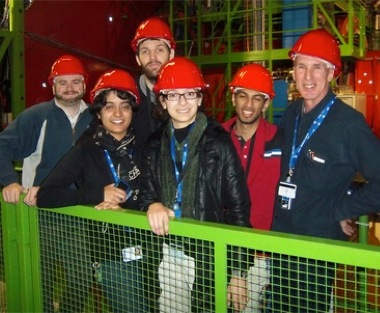When Lina Necib (CAS’12) was a ten-year-old in Tunisia, she says people laughed when she said she wanted to be a physicist. yet in just four short years at the College of Arts & Sciences, she mastered English (her third language), double-majored in physics and math, was elected to Phi Beta Kappa, worked for seven months at the European Organization for Nuclear Research (CERN) with the world’s top scientists, graduated summa cum laude and with distinction, and earned a coveted spot in MIT’s particle physics PhD program. With those credentials, she quips, people don’t question her choices as much these days.

The BU CERN semester abroad students at the Compact Muon Solenoid (CMS) detector underground. CMS and ATLAS (A Toroidal LHC Apparatus) are the two main experiments at the Large Hadron Collider searching for the Higgs particle. From left: CAS physics graduate student Cory Fantasia, Karishma Sekhon (’12), Daniel Shaffer (’13, ENG’13), Lina Necib (’12), Nafiun Awal (’12), and BU at CERN advisor CAS Physics Professor Larry Sulak. Photo courtesy of Lina Necib
Can you explain what CERN is, for the non-physicist?
It’s a big laboratory with many experiments, even though most people have only heard about the Large Hadron Collider (LHC), which is its biggest experiment so far. The LHC studies particle physics. It is colliding protons together, and from those collisions we look at whatever particles they make. Then we try to draw conclusions about which particles exist, which don’t, the properties of some particles, etc.
Is that the work you were doing?
Yes. What I was doing was looking for this particle, which we call the Higgs boson. The concept of the Higgs is that it’s basically the origin of mass. Physicists always wondered why some particles have small mass, some particles have a higher one, and in the sixties it was theorized that there exists a particle—the Higgs—that interacts with all these particles that we know and gives them mass. The LHC was really built to find the Higgs, and so at CERN, we looked at whatever’s left over after those interactions and looked for evidence of the Higgs.
In July, scientists around the world were excited that evidence of the Higgs boson was finally spotted. Why is the Higgs important?
The discovered particle—which is compatible with the Standard Model Higgs, but that needs to be confirmed—answers one of the most fundamental questions of nature: the origin of mass. It is a tremendous start that will shape all of the theories beyond the Standard Model. It is an exciting new beginning and a huge milestone for physics.
What was it like working with some of the most prominent physicists in the world at CERN?
BU is the only program that has undergrads at CERN. Our professor introduced us to people we actually learned about in textbooks. When you see those people in real life, all you can think is, “This is the most fascinating place in the world.” And he would point out scientists, saying, “Oh yeah, that guy got a Nobel. That guy got a Nobel. That guy got a Nobel.” For an undergrad scientist, it’s like being a kid in a chocolate store. But at the same time, at CERN, even if you’re an undergrad, you’re treated as a professional.
What is it about working in particle physics that excites you?
It’s the most fundamental thing in the world, the most fundamental science; you cannot get any deeper than that. I’ve heard a lot of professors say that, and it’s so true. If you know what a proton is, you cannot infer the anatomy of human beings, although they are made out of protons. That’s a completely different thing. So in particle physics, you’re not going to really know everything about the universe; that’s just not possible. But I find it absolutely fascinating to go back so early in time where everything just barely started and see the origin of it all.
Read more at BU Today.